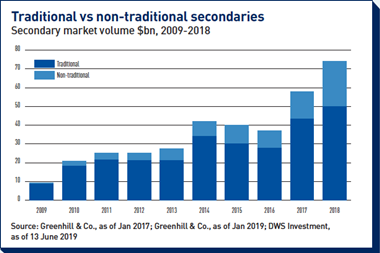According to investment consultancy bfinance, 2019 was the first ever year in which searches conducted by investors for real asset debt outweighed, in dollar terms, searches for corporate private debt.
While overall private debt fundraising in 2019 dropped to $147bn (€133.6bn), down from $166bn in 2018, this decline was primarily attributed to corporate debt, where new fundraising dropped by 17%, the firm disclosed.
By comparison, infrastructure debt fundraising rose from $9bn in 2018 to $14bn in 2019 – the second highest figure recorded, exceeded only in 2015. Real estate debt fundraising dipped only slightly – from $29bn to $27bn – following an exceptionally strong fundraising wave in 2013-17, with an average of $35bn per year, bfinance’s latest research showed.
“We note new investors entering this sector. These include defined contribution schemes in certain markets who are beginning to tap into illiquid strategies, headlined by UK NEST’s infrastructure debt commitment in 2019, and insurance companies, where regulatory changes have improved treatment for unrated debt in general and infrastructure debt in particular,” the firm stated.
NEST, the UK’s master trust with assets under management worth £8.3bn (€9.8bn) launched a new procurement last September inviting fund managers to tender for unlisted/direct infrastructure equity funds.
The pension scheme “believes private infrastructure equity investments can offer huge opportunities for its 8.5 million members”, it stated then.
Bfinance said investors that established first-time private debt allocations for the post-global financial crisis period – primarily targeting corporate debt – are seeking diversification as spreads in direct lending continue to decline.
It said: “This maturation has further supported real asset debt demand. Current appetite spans an immensely broad risk/return spectrum. At the lower end, demand for senior infrastructure debt from institutions seeking an alternative to investment grade fixed income is not a new phenomenon but the sector is becoming increasingly commoditised, with an ongoing decline in spreads.”
At the riskier end, bfinance is seeing pension funds with real estate and infrastructure equity portfolios shifting towards debt. Real estate debt has been the major beneficiary of this since 2013, its research shows.
“Yet we also note the emergence of infrastructure direct lending – increasingly recognised as a space in its own right – including senior secured loans to companies backed by infrastructure assets and infrastructure mezzanine loans.
“Whether these offer a route to superior risk-adjusted returns or signify an increasingly stretched market remains to be seen.”
Alternatives as biggest diversifiers
JPMorgan Asset Management has said that investors should increasingly consider alternatives as their biggest portfolio diversifiers for the year ahead, as the current market environment continues to drive investors in search of yield and steady returns.
The firm has released its second annual Global Alternatives Outlook, providing a 12-18-month outlook across key alternative asset classes and highlighting the views of its top management and strategists from JPMorgan AM’s 15 distinct alternatives investment engines.
Anton Pil, global head of alternatives, said: “In this delicately balanced investment climate, investors should increasingly consider the role alternatives can play as both a diversifier and a potential source of steady income without adding to a portfolio’s equity risk.”
He said: “Across the industry, there remains a lack of nuanced alternatives investment guidance that reflects the complexities of the asset class.”
The report also provides an alternatives framework for investors to build resilient portfolios, by categorising asset classes according to their role in the portfolio, divided into core foundation, core complements and potential return enhancers.
Additionally, it showed that 2020 will be a critical year for hedge fund managers to increase the integration of environmental, social and governance (ESG) criteria and sustainability across their businesses and investment activities.
Based on their investment objectives, Pil said, investors should focus on assets that have the ability to provide clear visibility into long-term yield.
Sector rotation key for hedge fund strategies
K2 Advisors, a provider of integrated hedge fund and alternative solutions, has said sector rotation appears to be a key factor for hedge fund strategy investing in 2020.
“As we look toward what might drive hedge fund returns in 2020, a key consideration for us is staying on top of sector and regional rotations in equity and fixed income markets,” said Brooks Ritchey and Robert Christian, senior managing directors and co-heads of investment research and management at the firm.
The duo said there are increasing signs pointing to a shift in financial markets from growth- and defensive-driven sentiment to more focus on cyclical and value factors. This trend could continue to fuel a rotation of investor flows throughout the year.
Value-oriented investments have stabilised and shown improvement, while long-favoured growth-oriented peers have found less momentum in late 2019.
“As we look toward 2020, a key consideration for us is staying on top of sector and regional rotations,” they said.



























No comments yet